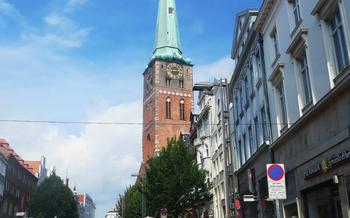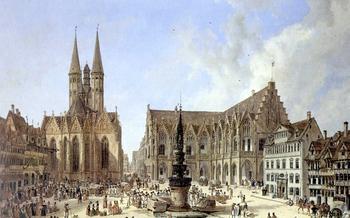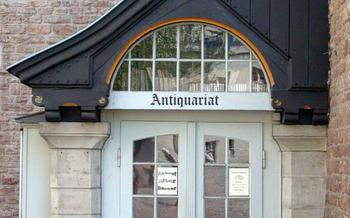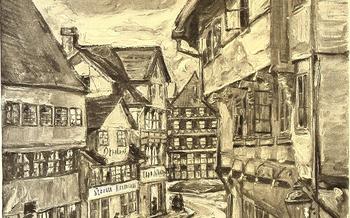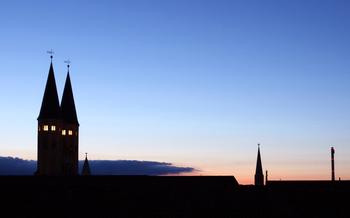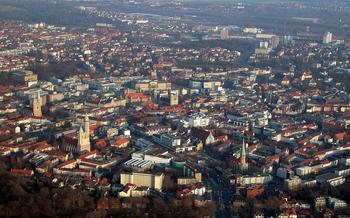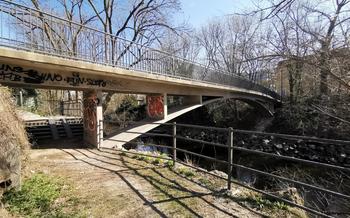
Kirche St. Aegidien (St. Aegidien Church)
- A Historical Gem in Braunschweig's Heart:
- Step Back in Time: The Romanesque Origins
- Gothic Elegance: A Transformation in Architecture
- The Striking Bell Tower: A Beacon of Faith
- Awe-Inspiring Interior: A Sanctuary of Worship
- A Place of Worship and Community
- The Organ: A Masterpiece of Sound
- Exploring the Neighborhood: A Cultural Tapestry
- Events and Exhibitions: A Living Cultural Space
- Guided Tours: Unveiling Hidden Treasures
- Photography and Social Media: Capturing the Beauty
- Accessibility for All: Inclusive Experiences
- Insider Tip: Hidden Gems to Discover
A Historical Gem in Braunschweig's Heart:
In the heart of Braunschweig, nestled amidst the cobblestone streets and half-timbered houses, stands the Kirche St. Aegidien, a magnificent testament to the city's rich history and architectural heritage. Dating back to the 12th century, this Romanesque-Gothic church has witnessed the passage of time, evolving through the centuries to become an iconic landmark of Braunschweig.
St. Aegidien Church proudly displays a harmonious blend of Romanesque and Gothic architectural styles, showcasing the transition from one era to another. Its sturdy Romanesque foundations give way to the graceful Gothic elements, creating a captivating visual narrative that tells the story of Braunschweig's architectural evolution.
The church's convenient location in the city center makes it easily accessible to visitors. Situated just a short walk from the bustling Altstadtmarkt, St. Aegidien Church invites you to step into a realm of tranquility and marvel at its architectural splendor.
Step Back in Time: The Romanesque Origins
The story of St. Aegidien Church begins in the early 12th century, when Braunschweig was a thriving city on the rise. The original church, constructed around 1115, was a testament to the city's growing prosperity and religious fervor. Built in the Romanesque style, which dominated European architecture at the time, the church displayed several characteristic features that have stood the test of time.
The exterior of the early St. Aegidien Church showcased sturdy walls, rounded arches, and a simple yet elegant design. Inside, the nave was defined by massive pillars and a barrel-vaulted ceiling, creating a sense of grandeur and spaciousness. The church's Romanesque heritage is still evident in the rounded windows, decorative carvings, and the overall harmonious proportions of the building.
Braunschweig, during this period, was a city of great importance. As a major trading center on the Oker River, it attracted merchants, artisans, and scholars from across the region. The construction of St. Aegidien Church reflected the city's growing wealth and influence, as well as its deep-rooted Christian faith. The church became a spiritual and communal hub, serving as a place of worship, gathering, and celebration for the people of Braunschweig.
Gothic Elegance: A Transformation in Architecture
In the 13th century, the Kirche St. Aegidien underwent a significant transformation, transitioning from its Romanesque origins to the elegant Gothic style. This period marked a shift in artistic and religious trends, and the church's architecture reflects this evolution.
The exterior of the church showcases notable Gothic features, including pointed arches, ribbed vaults, and flying buttresses. These elements not only enhanced the structural stability of the building but also created a sense of verticality and lightness. The pointed arches, in particular, allowed for larger windows, flooding the interior with natural light and creating a more uplifting atmosphere.
Inside the church, the Gothic influence is equally evident. The nave features a series of slender columns with intricate capitals, supporting the ribbed vaults that soar overhead. The ribbed vaults, a hallmark of Gothic architecture, distribute the weight of the roof more efficiently, allowing for thinner walls and larger windows. The result is a spacious and airy interior that invites contemplation and awe.
These Gothic additions to the Kirche St. Aegidien not only transformed its appearance but also reflected the changing religious and cultural landscape of Braunschweig. The Gothic style, with its emphasis on light, height, and ornamentation, was seen as a fitting expression of the growing power and influence of the church during this period.
The Striking Bell Tower: A Beacon of Faith
The bell tower of St. Aegidien Church stands tall, an architectural masterpiece that complements the church's overall grandeur. Constructed in the 15th century, this magnificent tower soars high above the city, reaching a height of approximately 65 meters. Its intricate Gothic style harmonizes beautifully with the Romanesque elements of the church, creating a visually stunning spectacle.
The tower's exterior showcases exquisite craftsmanship, featuring intricate carvings and decorative elements that reflect the artistic prowess of the era. Its graceful spire, adorned with intricate finials, seems to pierce the sky, beckoning the faithful to seek spiritual guidance within the church's walls.
The bells housed within the tower play a significant role in the daily life of Braunschweig's residents. Their melodious chimes reverberate through the city streets, marking the hours and calling the faithful to prayer. These bells have witnessed centuries of history, serving as a constant reminder of the enduring presence of St. Aegidien Church in the heart of Braunschweig.
Awe-Inspiring Interior: A Sanctuary of Worship
Stepping inside the Kirche St. Aegidien is like entering a realm of tranquility and awe-inspiring beauty. The spacious nave, with its impressive dimensions, creates a sense of grandeur and devotion. The vaulted ceilings, supported by slender pillars, soar upwards, drawing the eye towards the heavens. The intricate web of ribbed vaults adds a touch of Gothic elegance to the otherwise Romanesque interior.
Stained-glass windows, with their vibrant hues and intricate designs, bathe the sanctuary in a warm and colorful light. These windows depict biblical scenes and stories, inviting visitors to contemplate the divine. The play of light through the stained glass creates a mesmerizing effect, casting ever-changing patterns on the walls and floor.
The harmonious blend of Romanesque and Gothic styles in the interior reflects the church's rich history and architectural evolution. The simplicity and solidity of the Romanesque style are juxtaposed with the soaring heights and intricate details of the Gothic, creating a visually stunning and spiritually uplifting space.
Whether seeking solace, inspiration, or a deeper connection with history and faith, visitors to the Kirche St. Aegidien will find a sanctuary of worship and a place where the sacred and the sublime converge.
A Place of Worship and Community
Kirche St. Aegidien has stood as a spiritual beacon for Braunschweig's residents for centuries. Its grand nave has witnessed countless moments of devotion, prayer, and reflection. The church's enduring significance extends beyond its architectural and historical value; it is a living testament to the power of faith and the enduring spirit of community.
Throughout the ages, Kirche St. Aegidien has served as a gathering place for religious observances, communal celebrations, and moments of quiet contemplation. Its spacious interior has provided a sanctuary for worshippers seeking solace, guidance, and inspiration. The church's rich history is intertwined with the lives of Braunschweig's citizens, who have found comfort and strength within its walls.
Even today, Kirche St. Aegidien remains a vibrant center of religious life. Regular church services, special events, and community gatherings are held within its hallowed halls, fostering a sense of belonging and spiritual connection among the faithful. Visitors of all faiths are welcome to attend services and experience the church's welcoming atmosphere.
The Organ: A Masterpiece of Sound
Kirche St. Aegidien is home to a remarkable organ, a masterpiece of sound that has captivated audiences for centuries. Built in the 16th century, this magnificent instrument boasts over 4,000 pipes, each meticulously crafted to produce a rich and diverse range of tones. The organ's intricate carvings and ornate decorations complement the church's Gothic architecture, creating a harmonious blend of visual and auditory splendor.
Throughout its history, the organ has been played by renowned musicians and composers, including Heinrich Schütz, who served as the church's Kapellmeister from 1628 to 167The organ's versatility allows it to perform a wide repertoire of music, from sacred hymns to secular compositions. Visitors can regularly experience the organ's majestic sound during church services, concerts, and recitals held throughout the year.
The church's organ is not merely a musical instrument; it is a symbol of Braunschweig's rich cultural heritage. Its intricate craftsmanship and enduring legacy make it a must-see attraction for music enthusiasts, history buffs, and anyone who appreciates the beauty of artistic creation.
Exploring the Neighborhood: A Cultural Tapestry
Kirche St. Aegidien is nestled in the heart of Braunschweig's historic city center, surrounded by a vibrant tapestry of cultural attractions. A short stroll from the church, visitors can immerse themselves in the bustling Altstadtmarkt, the city's central square. Here, colorful market stalls selling fresh produce, handmade crafts, and local delicacies create a lively atmosphere. The square is also home to the magnificent town hall, a stunning example of Renaissance architecture.
Just a stone's throw away from the church lies Dankwarderode Castle, a former residence of the Dukes of Braunschweig. This impressive fortress, with its imposing towers and well-preserved medieval architecture, houses the Dankwarderode Museum, which showcases a fascinating collection of art and artifacts from the region's rich history.
The surrounding neighborhood is a treasure trove of hidden gems, including charming cafes, independent boutiques, and art galleries. Visitors can wander along the narrow cobbled streets, admiring the beautifully preserved half-timbered houses that line the way. The area is also home to several theaters, cinemas, and concert venues, offering a diverse range of cultural experiences.
Events and Exhibitions: A Living Cultural Space
Kirche St. Aegidien is not merely a place of worship; it is also a vibrant cultural venue that hosts a variety of events and exhibitions throughout the year. These events transform the church into a living cultural space, attracting visitors from near and far.
Past events have included art exhibitions showcasing local and international artists, concerts featuring renowned musicians and choirs, and historical reenactments that bring the church's past to life. The church has also hosted lectures, workshops, and film screenings, offering opportunities for learning and engagement.
Upcoming events at Kirche St. Aegidien are eagerly anticipated by the community. Visitors can check the church's website or social media pages for the latest updates on upcoming events and exhibitions.
These cultural events not only enhance the church's spiritual significance but also contribute to the city's vibrant cultural landscape. Kirche St. Aegidien stands as a testament to the power of faith and art, seamlessly blending the sacred and the secular.
Guided Tours: Unveiling Hidden Treasures
Kirche St. Aegidien offers guided tours that provide an in-depth exploration of its history, architecture, and significance. These tours are led by knowledgeable guides who share fascinating insights and anecdotes about the church. Visitors can learn about the church's construction, its transformation from Romanesque to Gothic style, the symbolism behind the sculptures and reliefs, and the stories of the people who have worshipped within its walls.
Guided tours are available on a regular basis, and reservations can be made in advance through the church's website or by contacting the parish office. The tours typically last for about an hour and are suitable for visitors of all ages.
For those who prefer a more personalized experience, private tours can also be arranged. These tours allow visitors to tailor the tour to their specific interests, whether it's focusing on the church's art, architecture, or religious significance.
Photography and Social Media: Capturing the Beauty
Kirche St. Aegidien's striking architecture and intricate details make it a photographer's paradise. While capturing the church's grandeur, remember to be respectful of the sacred space and any ongoing religious activities. For the best shots, arrive early in the day to take advantage of the soft morning light. Experiment with different angles to capture the church's imposing facade, its graceful bell tower reaching towards the sky, and the intricate carvings adorning its exterior. Inside, focus on the soaring vaulted ceilings, the delicate stained-glass windows, and the ornate sculptures.
Share your stunning captures on social media, using relevant hashtags like #KircheStAegidien, #Braunschweig, and #GermanArchitecture. Inspire your followers with the church's rich history and architectural marvels. Remember to tag the church's official social media accounts to connect with a broader community of enthusiasts.
Accessibility for All: Inclusive Experiences
Kirche St. Aegidien is committed to providing an inclusive and welcoming environment for all visitors, regardless of their abilities. The church features several accessibility features to ensure that everyone can fully enjoy and appreciate its architectural and spiritual wonders.
Visitors with mobility impairments can easily access the church through its wheelchair-accessible entrance. Inside, the spacious nave and aisles provide ample room for wheelchairs to maneuver. Additionally, the church offers a designated seating area for individuals with reduced mobility, ensuring they can actively participate in services and events.
For visitors with visual impairments, the church provides large-print hymnals and service programs. Audio guides with detailed descriptions of the church's history, architecture, and artwork are also available upon request. These guides allow visitors to explore the church at their own pace and learn about its many fascinating features.
Kirche St. Aegidien is more than just a historical landmark; it is a living, breathing community that welcomes people from all walks of life. The church's commitment to accessibility reflects its belief in the power of inclusivity and its desire to create a welcoming space for everyone.
Insider Tip: Hidden Gems to Discover
Kirche St. Aegidien holds many hidden treasures waiting to be discovered by curious visitors. One such gem is the intricate astronomical clock located in the church's sacristy. This beautifully preserved clock, dating back to the 16th century, is a marvel of engineering and craftsmanship. Its intricate mechanisms display the time, date, and astronomical phenomena such as the phases of the moon and the positions of the planets.
Another hidden gem is the "Green Vault" or "Grünes Gewölbe," a secret chamber tucked away beneath the church. Here, visitors can marvel at a collection of precious artifacts, including gold and silver objects, rare coins, and exquisite jewelry. The Green Vault offers a glimpse into the opulent history of Braunschweig and the wealth of its former rulers.
For those who venture outside the church, the surrounding area is filled with hidden gems waiting to be explored. A short walk from the church leads to the Altstadtmarkt, the city's historic market square. Here, visitors can soak in the vibrant atmosphere, admire the colorful half-timbered houses, and indulge in local delicacies at the many restaurants and cafes.

